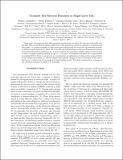Transient hot electron dynamics in single-layer TaS2
View/
Date
16/04/2019Author
Grant ID
URF/R/180026
PLP-2015-144
2016-006
Metadata
Show full item recordAbstract
Using time- and angle-resolved photoemission spectroscopy, we study the response of metallic single layer TaS2 in the 1H structural modification to the generation of excited carriers by a femtosecond laser pulse. A complex interplay of band structure modifications and electronic temperature increase is observed and analyzed by direct fits of model spectral functions to the two-dimensional (energy and k-dependent) photoemission data. Upon excitation, the partially occupied valence band is found to shift to higher binding energies by up to ≈ 100 meV, accompanied by electronic temperatures exceeding 3000~K. These observations are explained by a combination of temperature-induced shifts of the chemical potential, as well as temperature-induced changes in static screening. Both contributions are evaluated in a semi-empirical tight-binding model. The shift resulting from a change in the chemical potential is found to be dominant.
Citation
Andreatta , F , Rostami , H , Grubišić Čabo , A , Bianchi , M , E. Sanders , C , Biswas , D , Cacho , C , J. H. Jones , A , T. Chapman , R , Springate , E , King , P D C , Miwa , J A , Balatsky , A , Ulstrup , S & Hofmann , P 2019 , ' Transient hot electron dynamics in single-layer TaS 2 ' , Physical Review. B, Condensed matter and materials physics , vol. 99 , 165421 . https://doi.org/10.1103/PhysRevB.99.165421
Publication
Physical Review. B, Condensed matter and materials physics
Status
Peer reviewed
ISSN
1098-0121Type
Journal article
Rights
Copyright © 2019, American Physical Society. This work has been made available online in accordance with the publisher's policies. This is the author created accepted version manuscript following peer review and as such may differ slightly from the final published version. The final published version of this work is available at https://doi.org/10.1103/PhysRevB.99.165421
Description
Authors gratefully acknowledge funding from VILLUM FONDEN through the Young Investigator Program (Grant No. 15375) and the Centre of Excellence for Dirac Materials (Grant No. 11744), the Danish Council for Independent Research, Natural Sciences under the Sapere Aude program (Grants No. DFF-4002-00029, No. DFF-6108-00409, and No. DFF-4090-00125), the Aarhus University Research Foundation, The Leverhulme Trust and The Royal Society.Collections
Items in the St Andrews Research Repository are protected by copyright, with all rights reserved, unless otherwise indicated.

